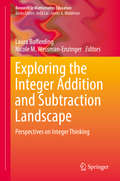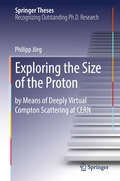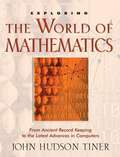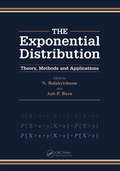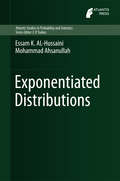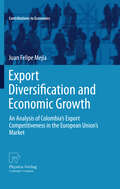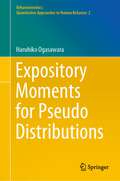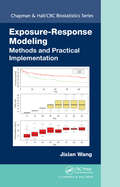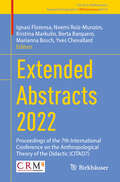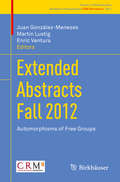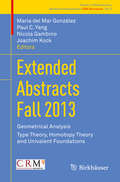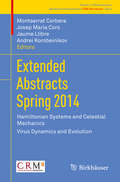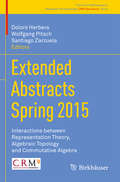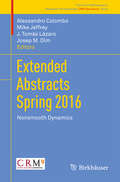- Table View
- List View
Exploring the Impact of Extended Reality (Information Systems Engineering and Management #38)
by Dac-Nhuong Le Shashi Kant Gupta Nitu Maurya Toufik MziliThis book offers a groundbreaking exploration of how Extended Reality (XR) technologies can drive environmental sustainability. By integrating virtual, augmented, and mixed realities, it provides innovative solutions to enhance understanding and inspire action on environmental issues. The text is meticulously curated to cover the multifaceted applications of XR, from revolutionizing environmental practices with deep learning to leveraging quantum computing for sustainable solutions. It highlights the synergy between XR and artificial intelligence in optimizing supply chains and enhancing data analytics. Aimed at researchers, practitioners, and policymakers, this resource underscores the critical role of XR in environmental advocacy, emphasizing its potential in effective communication and behavior change. The book also delves into immersive education, fostering a culture of environmental stewardship through experiential learning. Ultimately, it calls for interdisciplinary collaboration to address pressing environmental challenges, envisioning a future where XR technologies are pivotal in safeguarding our planet.
Exploring the Infinite: An Introduction to Proof and Analysis (Textbooks in Mathematics)
by Jennifer BrooksExploring the Infinite addresses the trend toward a combined transition course and introduction to analysis course. It guides the reader through the processes of abstraction and log- ical argumentation, to make the transition from student of mathematics to practitioner of mathematics. This requires more than knowledge of the definitions of mathematical structures, elementary logic, and standard proof techniques. The student focused on only these will develop little more than the ability to identify a number of proof templates and to apply them in predictable ways to standard problems. This book aims to do something more; it aims to help readers learn to explore mathematical situations, to make conjectures, and only then to apply methods of proof. Practitioners of mathematics must do all of these things. The chapters of this text are divided into two parts. Part I serves as an introduction to proof and abstract mathematics and aims to prepare the reader for advanced course work in all areas of mathematics. It thus includes all the standard material from a transition to proof" course. Part II constitutes an introduction to the basic concepts of analysis, including limits of sequences of real numbers and of functions, infinite series, the structure of the real line, and continuous functions. Features Two part text for the combined transition and analysis course New approach focuses on exploration and creative thought Emphasizes the limit and sequences Introduces programming skills to explore concepts in analysis Emphasis in on developing mathematical thought Exploration problems expand more traditional exercise sets
Exploring the Integer Addition and Subtraction Landscape: Perspectives on Integer Thinking (Research in Mathematics Education)
by Laura Bofferding Nicole M. Wessman-EnzingerOver the past few decades there has been increased interest in how students and teachers think and learn about negative numbers from a variety of perspectives. In particular, there has been debate about when integers should be taught and how to teach them to best support students’ learning. This book brings together recent work from researchers to illuminate the state of our understanding about issues related to integer addition and subtraction with a goal of highlighting how the variety of perspectives support each other or contribute to the field in unique ways. In particular, this book focuses on three main areas of integer work: students’ thinking, models and metaphors, and teachers’ thinking. Each chapter highlights a theoretically guided study centered on integer addition and subtraction. Internationally known scholars help connect the perspectives and offer additional insights through section commentaries. This book is an invaluable resource to those who are interested in mathematics education and numerical thinking.
Exploring the Mathematical Education of Teachers Using TEDS-M Data
by Maria Teresa Tatto Michael C. Rodriguez Wendy M. Smith Mark D. Reckase Kiril BankovThis book uses the publicly available TEDS-M data to answer such questions as: How does teacher education contribute to the learning outcomes of future teachers? Are there programs that are more successful than others in helping teachers learn to teach mathematics? How does the local and national policy environment contribute to teacher education outcomes? It invites readers to explore these questions across a large number of international settings. The importance of preparing future mathematics teachers has become a priority across many nations. Across the globe nations have allocated resources and expertise to this endeavour. Yet in spite of the importance accorded to teacher education not much is known about different approaches to preparing knowledgeable teachers and whether these approaches do in fact achieve their purpose. The Mathematics Teacher Education and Development Study (TEDS-M) is the first, and to date the only, cross-national study using scientific and representative samples to provide empirical data on the knowledge that future mathematics teachers of primary and secondary school acquire in their teacher education programs. The study addresses the central importance of teacher knowledge in learning to teach mathematics by examining variation in the nature and influence of teacher education programs within and across countries. The study collected data on teacher education programs structure, curriculum and opportunities to learn, on teacher educators’ characteristics and beliefs, and on future mathematics teachers’ individual characteristics, beliefs, and mathematics and pedagogical knowledge across 17 countries providing a unique opportunity to explore enduring questions in the field.
Exploring the Size of the Proton
by Philipp JörgThis book is a rare jewel, describing fundamental research in a highly dynamic field of subatomic physics. It presents an overview of cross section measurements of deeply virtual Compton scattering. Understanding the structure of the proton is one of the most important challenges that physics faces today. A typical tool for experimentally accessing the internal structure of the proton is lepton–nucleon scattering. In particular, deeply virtual Compton scattering at large photon virtuality and small four-momentum transfer to the proton provides a tool for deriving a three-dimensional tomographic image of the proton. Using clear language, this book presents the highly complex procedure used to derive the momentum-dissected transverse size of the proton from a pioneering measurement taken at CERN. It describes in detail the foundations of the measurement and the data analysis, and includes exhaustive studies of potential systematic uncertainties, which could bias the result.
Exploring the World of Mathematics
by John Hudson TinerNumbers surround us. Just try to make it through a day without using any. It's impossible: telephone numbers, calendars, volume settings, shoe sizes, speed limits, weights, street numbers, microwave timers, TV channels, and the list goes on and on. The many advancements and branches of mathematics were developed through the centuries as people encountered problems and relied upon math to solve them. For instance: What timely invention was tampered with by the Caesars and almost perfected by a pope? Why did ten days vanish in September of 1752? How did Queen Victoria shorten the Sunday sermons at chapel? What important invention caused the world to be divided into time zones? What simple math problem caused the Mars Climate Orbiter to burn up in the Martian atmosphere? What common unit of measurement was originally based on the distance from the equator to the North Pole? Does water always boil at 212? Fahrenheit? What do Da Vinci's Last Supper and the Parthenon have in common? Why is a computer glitch called a "bug"? It's amazing how ten simple digits can be used in an endless number of ways to benefit man. The development of these ten digits and their many uses is the fascinating story you hold in your hands: Exploring the World of Mathematics.
Explosions in Underground Coal Mines: Risk Assessment And Control
by Jianwei ChengThis book addresses the hazard of gas explosions in sealed underground coal mines, and how the risk of explosion can be assessed, modeled, and mitigated. With this text, coal mine operators and managers will be able to identify the risks that lead to underground mine gas explosions, and implement practical strategies to optimize mining safety for workers. In six chapters, the book offers a framework for understanding the sealed coal mine atmosphere, the safety characteristics that are currently in place, and the guidelines to be followed by engineers to improve upon these characteristics. The first part of the book describes the importance and characteristics of underground gas mine explosions in a historical context with data showing the high number of fatalities from explosion incidents, and how risk has been mitigated in the past. Chapters also detail mathematical models and explosibility diagrams for determining and understanding the risk factors involved in mine explosions. Readers will also learn about safety operations, and assessments for the sealed mine atmosphere. With descriptions of chapter case studies, mining engineers and researchers will learn how to apply safety measures in underground coal mines to improve mining atmospheres and save lives.
Exponential Distribution: Theory, Methods and Applications
by K. BalakrishnanThe exponential distribution is one of the most significant and widely used distribution in statistical practice. It possesses several important statistical properties, and yet exhibits great mathematical tractability. This volume provides a systematic and comprehensive synthesis of the diverse literature on the theory and applications of the expon
Exponentiated Distributions
by Essam K. AL-Hussaini Mohammad AhsanullahThis book contains entirely new results, not to be found elsewhere. Furthermore, additional results scattered elsewhere in the literature are clearly presented. Several well-known distributions such as Weibull distributions, exponentiated Burr type XII distributions and exponentiated exponential distributions and their properties are demonstrated. Analysis of real as well as well-simulated data are analyzed. A number of inferences based on a finite mixture of distributions are also presented.
Export Diversification and Economic Growth
by Juan Felipe MejíaThe main research problem addressed in the book is the one regarding the role that export diversification could play for enhancing economic growth in Colombia, both in terms of new products and new geographic markets. The underlying motivation for centering the analysis on the European Union's market are manifold, reaching from the evident concentration of exports - both in terms of composition and markets- that Colombia still shows, to the small amount of empirical studies analyzing the current status and potentialities of the commercial relations between Colombia and the European Union.
Expository Moments for Pseudo Distributions (Behaviormetrics: Quantitative Approaches to Human Behavior #2)
by Haruhiko OgasawaraThis book provides expository derivations for moments of a family of pseudo distributions, which is an extended family of distributions including the pseudo normal (PN) distributions recently proposed by the author. The PN includes the skew normal (SN) derived by A. Azzalini and the closed skew normal (CSN) obtained by A. Domínguez-Molina, G. González-Farías, and A. K. Gupta as special cases. It is known that the CSN includes the SN and other various distributions as special cases, which shows that the PN has a wider variety of distributions. The SN and CSN have symmetric and skewed asymmetric distributions. However, symmetric distributions are restricted to normal ones. On the other hand, symmetric distributions in the PN can be non-normal as well as normal. In this book, for the non-normal symmetric distributions, the term “kurtic normal (KN)” is used, where the coined word “kurtic” indicates “mesokurtic, leptokurtic, or platykurtic” used in statistics. The variety of the PN was made possible using stripe (tigerish) and sectional truncation in univariate and multivariate distributions, respectively. The proofs of the moments and associated results are not omitted and are often given in more than one method with their didactic explanations.
Exposure-Response Modeling: Methods and Practical Implementation (Chapman & Hall/CRC Biostatistics Series)
by Jixian WangDiscover the Latest Statistical Approaches for Modeling Exposure-Response RelationshipsWritten by an applied statistician with extensive practical experience in drug development, Exposure-Response Modeling: Methods and Practical Implementation explores a wide range of topics in exposure-response modeling, from traditional pharmacokinetic-pharmacody
Extended Abstracts 2021/2022: Ghent Analysis and PDE Seminar (Trends in Mathematics #2)
by Michael Ruzhansky Karel Van BockstalThis book offers an overview of the research results presented by group members and guests of the Ghent Analysis & PDE Center during the weekly seminar that took place from 2021 to 2022. It is an informal event of the Analysis & PDE Center and associated researchers, where everyone can present their work or relevant literature for about 20-30 minutes. The seminar aims to exchange ideas and foster effective learning and collaboration.In this book, group members and guests summarise their results presented during the seminar and provide outlooks for future work. In this way, the book also provides an overview of the recent developments in the Ghent Analysis & PDE Center. The main topics are functional analysis, Fourier analysis, noncommutative analysis, geometric analysis, partial differential equations of different types, harmonic analysis, functional inequalities, pseudo-differential operators, fractional derivatives, special functions, microlocal analysis, inverseproblems and imaging. The target audience of this book is any researcher working in the above fields.
Extended Abstracts 2021/2022: Methusalem Lectures (Trends in Mathematics #3)
by Michael Ruzhansky Duván Cardona Joel RestrepoThis volume presents modern developments in analysis, PDEs and geometric analysis by some of the leading worldwide experts, prominent junior and senior researchers who were invited to be part of the Ghent Analysis & PDE Center Methusalem Seminars from 2021 to 2022. The contributions are from the speakers of the Methusalem Colloquium, Methusalem Junior Seminar and Geometric Analysis Seminar. The volume has two main topics: 1. Analysis and PDEs. The volume presents recent results in fundamental problems for solving partial integro-differential equations in different settings such as Euclidean spaces, manifolds, Banach spaces, and many others. Discussions about the global and local solvability using micro-local and harmonic analysis methods, studies of new techniques and approaches arising from a physical perspective or the mathematical point of view have also been included. Several connected branches arising in this regard are shown. 2. Geometric analysis. The volume presents studies of modern techniques for elliptic and subelliptic PDEs that in recent times have been used to establish new results in differential geometry and differential topology. These topics involve the intrinsic research in microlocal analysis, geometric analysis, and harmonic analysis abroad. Different problems having relevant geometric information for different applications in mathematical physics and other problems of classification have been considered.
Extended Abstracts 2022: Proceedings of the 7th International Conference on the Anthropological Theory of the Didactic (CITAD7) (Trends in Mathematics #16)
by Marianna Bosch Yves Chevallard Berta Barquero Ignasi Florensa Noemí Ruiz-Munzón Kristina MarkulinThis book includes contributions from the conference held in Barcelona in 2022. It brings together researchers interested in the Anthropological Theory of the Didactic (ATD) and aims at the following objectives: Establishing an updated overview of the results and progress in the ATD, concerning both basic research and the development of education systems, including teacher education; Developing a research programme around the most relevant open problems, either related to difficulties affecting education systems or the development of didactics as a scientific discipline; Identifying and studying the specific problems raised by the extension of the ATD’s conceptual and methodological tools to other fields. The conference is structured around the following thematic axis: Axis 1: Development of the foundations, tools and aims of research in the framework of the ATD – Axis 2: The Curriculum Problem and the paradigm of questioning the world – Axis 3: ATD and the professionalization of the teaching profession.
Extended Abstracts EuroComb 2021: European Conference on Combinatorics, Graph Theory and Applications (Trends in Mathematics #14)
by Jaroslav Nešetřil Guillem Perarnau Juanjo Rué Oriol SerraThis book collects the extended abstracts of the accepted contributions to EuroComb21. A similar book is published at every edition of EuroComb (every two years since 2001) collecting the most recent advances in combinatorics, graph theory, and related areas. It has a wide audience in the areas, and the papers are used and referenced broadly.
Extended Abstracts Fall 2012
by Juan González-Meneses Martin Lustig Enric VenturaThis volume features seventeen extended conference abstracts corresponding to selected talks given by participants at the CRM research program "Automorphisms of Free Groups: Algorithms, Geometry and Dynamics", which took place at the Centre de Recerca Matemàtica in Barcelona in fall 2012. Most of them are short articles giving preliminary presentations of new results not yet published in regular research journals. The articles are the result from a direct collaboration among active researchers in the area after working in a dynamic and productive atmosphere. The book is intended for established researchers in the area of Group Theory, as well as for PhD and postdoc students who wish to learn more about the latest advances in this active area of research.
Extended Abstracts Fall 2013
by Paul C. Yang Maria del Mar González Nicola Gambino Joachim KockThe two parts of the present volume contain extended conference abstracts corresponding to selected talks given by participants at the "Conference on Geometric Analysis" (thirteen abstracts) and at the "Conference on Type Theory, Homotopy Theory and Univalent Foundations" (seven abstracts), both held at the Centre de Recerca Matemàtica (CRM) in Barcelona from July 1st to 5th, 2013, and from September 23th to 27th, 2013, respectively. Most of them are brief articles, containing preliminary presentations of new results not yet published in regular research journals. The articles are the result of a direct collaboration between active researchers in the area after working in a dynamic and productive atmosphere. The first part is about Geometric Analysis and Conformal Geometry; this modern field lies at the intersection of many branches of mathematics (Riemannian, Conformal, Complex or Algebraic Geometry, Calculus of Variations, PDE's, etc) and relates directly to the physical world, since many natural phenomena posses an intrinsic geometric content. The second part is about Type Theory, Homotopy Theory and Univalent Foundations. The book is intended for established researchers, as well as for PhD and postdoctoral students who want to learn more about the latest advances in these highly active areas of research.
Extended Abstracts Fall 2019: Spaces of Analytic Functions: Approximation, Interpolation, Sampling (Trends in Mathematics #12)
by Anton Baranov Evgeny Abakumov Alexander Borichev Konstantin Fedorovskiy Joaquim Ortega-CerdàThis book collects the abstracts of the mini-courses and lectures given during the Intensive Research Program “Spaces of Analytic Functions: Approximation, Interpolation, Sampling” which was held at the Centre de Recerca Matemàtica (Barcelona) in October–December, 2019.The topics covered in this volume are approximation, interpolation and sampling problems in spaces of analytic functions, their applications to spectral theory, Gabor analysis and random analytic functions. In many places in the book, we see how a problem related to one of the topics is tackled with techniques and ideas coming from another.The book will be of interest for specialists in Complex Analysis, Function and Operator theory, Approximation theory, and their applications, but also for young people starting their research in these areas.
Extended Abstracts February 2016: Positivity And Valuations (Trends in Mathematics #9)
by Maria Alberich-Carramiñana Carlos Galindo Alex Küronya Joaquim RoéThis volume contains extended abstracts outlining selected talks and other selected presentations given by participants of the workshop "Positivity and Valuations", held at the Centre de Recerca Matemàtica (CRM) in Barcelona from February 22nd to 26th, 2016. They include brief research articles reporting new results, descriptions of preliminary work or open problems, and the outcome of work in groups initiated during the workshop. The general subject is the application of valuation theory to positivity questions in algebraic geometry. The topics covered range from purely algebraic problems like finite generation of semigroups and algebras defined by valuations, and properties of the associated Poincaré series, to more geometric questions like resolution of singularities and properties of Newton-Okounkov bodies, linked with non-archimedean geometry and tropical geometry.The book is intended for established researchers, as well as for PhD and postdoctoral students who want to learn more about the latest advances in these highly active areas of research.
Extended Abstracts MWCAPDE 2023: Methusalem Workshop on Classical Analysis and Partial Differential Equations (Trends in Mathematics #1)
by Michael Ruzhansky Berikbol TorebekThis collection consists of selected scientific results stemming from the conference "Methusalem Workshop on Classical Analysis and PDEs", held at the Ghent University from 27th February 2023 to 1st March 2023. The workshop was organized by the "Ghent Analysis & PDE Center". The presented materials mainly consist of scientific results on classical analysis and problems of PDEs. In particular, results on harmonic analysis, functional spaces, functional inequalities, inverse problems, non-local PDEs, non-classical problems of PDEs, integro-differential equations, hypoelliptic operators, pseudo-differential calculus, and others are given.
Extended Abstracts Spring 2014
by Montserrat Corbera Josep Maria Cors Jaume Llibre Andrei KorobeinikovThe two parts of the present volume contain extended conference abstracts corresponding to selected talks given by participants at the "Conference on Hamiltonian Systems and Celestial Mechanics 2014" (HAMSYS2014) (15 abstracts) and at the "Workshop on Virus Dynamics and Evolution" (12 abstracts), both held at the Centre de Recerca Matemàtica (CRM) in Barcelona from June 2nd to 6th, 2014, and from June 23th to 27th, 2014, respectively. Most of them are brief articles, containing preliminary presentations of new results not yet published in regular research journals. The articles are the result of a direct collaboration between active researchers in the area after working in a dynamic and productive atmosphere. The first part is about Central Configurations, Periodic Orbits and Hamiltonian Systems with applications to Celestial Mechanics - a very modern and active field of research. The second part is dedicated to mathematical methods applied to viral dynamics and evolution. Mathematical modelling of biological evolution currently attracts the interest of both mathematicians and biologists. This material offers a variety of new exciting problems to mathematicians and reasonably inexpensive mathematical methods to evolutionary biologists. It will be of scientific interest to both communities. The book is intended for established researchers, as well as for PhD and postdoctoral students who want to learn more about the latest advances in these highly active areas of research.
Extended Abstracts Spring 2015
by Dolors Herbera Wolfgang Pitsch Santiago ZarzuelaThis book includes 33 expanded abstracts of selected talks given at the two workshops "Homological Bonds Between Commutative Algebra and Representation Theory" and "Brave New Algebra: Opening Perspectives," and the conference "Opening Perspectives in Algebra, Representations, and Topology," held at the Centre de Recerca Matem#65533;tica (CRM) in Barcelona between January and June 2015. These activities were part of the one-semester intensive research program "Interactions Between Representation Theory, Algebraic Topology and Commutative Algebra (IRTATCA). " Most of the abstracts present preliminary versions of not-yet published results and cover a large number of topics (including commutative and non commutative algebra, algebraic topology, singularity theory, triangulated categories, representation theory) overlapping with homological methods. This comprehensive book is a valuable resource for the community of researchers interested in homological algebra in a broad sense, and those curious to learn the latest developments in the area. It appeals to established researchers as well as PhD and postdoctoral students who want to learn more about the latest advances in these highly active fields of research.
Extended Abstracts Spring 2016
by Alessandro Colombo Mike Jeffrey J. Tomàs Lázaro Josep M. OlmThis volume contains extended abstracts outlining selected talks and other selected presentations given by participants throughout the "Intensive Research Program on Advances in Nonsmooth Dynamics 2016", held at the Centre de Recerca Matem#65533;tica (CRM) in Barcelona from February 1st to April 29th, 2016. They include brief research articles reporting new results, descriptions of preliminary work or open problems, and outlines of prominent discussion sessions. The articles are all the result of direct collaborations initiated during the research program. The topic is the theory and applications of Nonsmooth Dynamics. This includes systems involving elements of: impacting, switching, on/off control, hybrid discrete-continuous dynamics, jumps in physical properties, and many others. Applications include: electronics, climate modeling, life sciences, mechanics, ecology, and more. Numerous new results are reported concerning the dimensionality and robustness of nonsmooth models, shadowing variables, numbers of limit cycles, discontinuity-induced bifurcations and chaos, determinacy-breaking, stability criteria, and the classification of attractors and other singularities. This material offers a variety of new exciting problems to mathematicians, but also a diverse range of new tools and insights for scientists and engineers making use of mathematical modeling and analysis. The book is intended for established researchers, as well as for PhD and postdoctoral students who want to learn more about the latest advances in these highly active areas of research.
Extended Abstracts Spring 2018: Singularly Perturbed Systems, Multiscale Phenomena and Hysteresis: Theory and Applications (Trends in Mathematics #11)
by Andrei Korobeinikov Magdalena Caubergh Tomás Lázaro Josep SardanyésThis volume contains extended abstracts outlining selected presentations delivered by participants of the joint international multidisciplinary workshop MURPHYS-HSFS-2018 (MUltiRate Processes and HYSteresis; Hysteresis and Slow-Fast Systems), dedicated to the mathematical theory and applications of the multiple scale systems, the systems with hysteresis and general trends in the dynamical systems theory. The workshop was jointly organized by the Centre de Recerca Matemàtica (CRM), Barcelona, and the Collaborative Research Center 910, Berlin, and held at the Centre de Recerca Matemàtica in Bellaterra, Barcelona, from May 28th to June 1st, 2018. This was the ninth workshop continuing a series of biennial meetings started in Ireland in 2002, and the second workshop of this series held at the CRM. Earlier editions of the workshops in this series were held in Cork, Pechs, Suceava, Lutherstadt and Berlin. The collection includes brief research articles reporting new results, descriptions of preliminary work, open problems, and the outcome of work in groups initiated during the workshop. Topics include analysis of hysteresis phenomena, multiple scale systems, self-organizing nonlinear systems, singular perturbations and critical phenomena, as well as applications of the hysteresis and the theory of singularly perturbed systems to fluid dynamics, chemical kinetics, cancer modeling, population modeling, mathematical economics, and control.The book is intended for established researchers, as well as for PhD and postdoctoral students who want to learn more about the latest advances in these highly active research areas.


